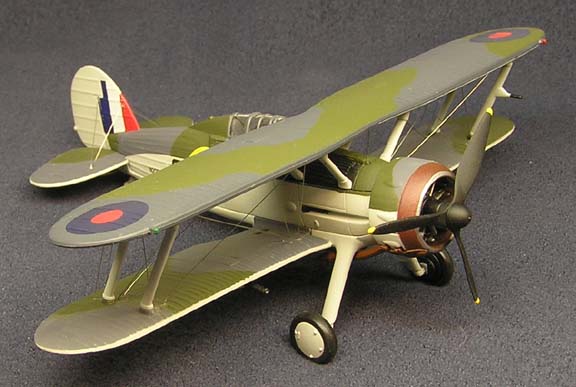Gloster Sea Gladiator Mk.I

Sub Lt. J. W. Sleigh, No. 804 Squadron, Fleet Air Arm
Hatston, Orkney Islands, July 1940
(Corgi Aviation Archive AA36202)
- Engine: One 840 h.p. Bristol Mercury VIIIA radial
- Span: 32 ft 3 in
- Length: 27 ft 5 in
- Height: 10 ft 4 in
- Weight: 3,730 lb empty / 5,400 lb loaded
- Crew: One
- Max Speed: 244 mph at 14,500 ft
- Service Ceiling: 33,000 ft
- Normal Range: 423 miles
- Armament: Four .303 cal Browning MG
- Notes: The Gloster Gladiator was the last British biplane fighter, a development of the Gauntlet with an enclosed single seat cockpit, cantilever landing gear, increased armament, and a 2-blade fixed pitch propeller. First flown in 1935, the Gladiator went into service with the RAF in 1936. The Mark I had a 840 hp Bristol Mercury IX air-cooled engine and the Mark II a Bristol Mercury VIIIA engine. The Sea Gladiator was the vaiant adopted by the Fleet Air Arm. It was fitted with a deck arrestor, catapult points, and carried a collapsible dinghy. Numbers built totalled a minimum of 756 (480 RAF, 60 RN; 216 export into 13 countries). Gladiators were also sold to Belgium, Finland, Latvia, Lithuania, Sweden, Norway, China, Ireland, Greece, Portugal, Egypt, Iraq, and South Africa. 804 Naval Air Squadron was formed in November 1939 from 769 squadron Sea Gladiators which had been detached to Hatston to counter enemy attacks on Scapa. The squadron subsequently embarked on HMS Glorious in April 1940 to provide fighter patrols during ferrying operations of 269 squadron RAF Gladiators to Norway, and then transferred to HMS Furious at Cambeltown in early May 1940. May until September 1940 was spent by 804 squadron at Hatston, operating in defence of Scapa Flow, and subsequently recognised as only one of two FAA squadrons operating with RAF Fighter Command in the Battle of Britain.



 Up
Up





 Up
Up